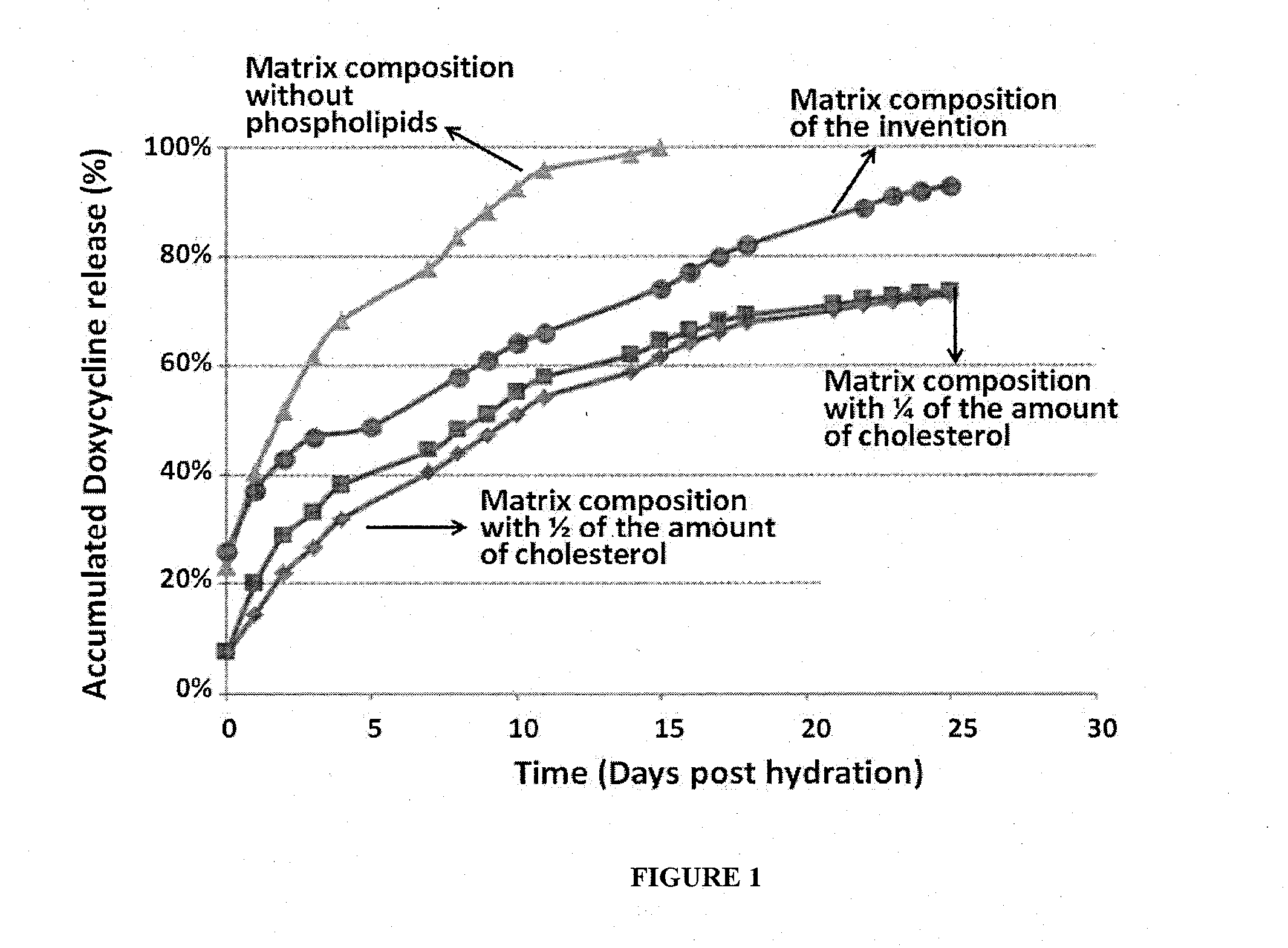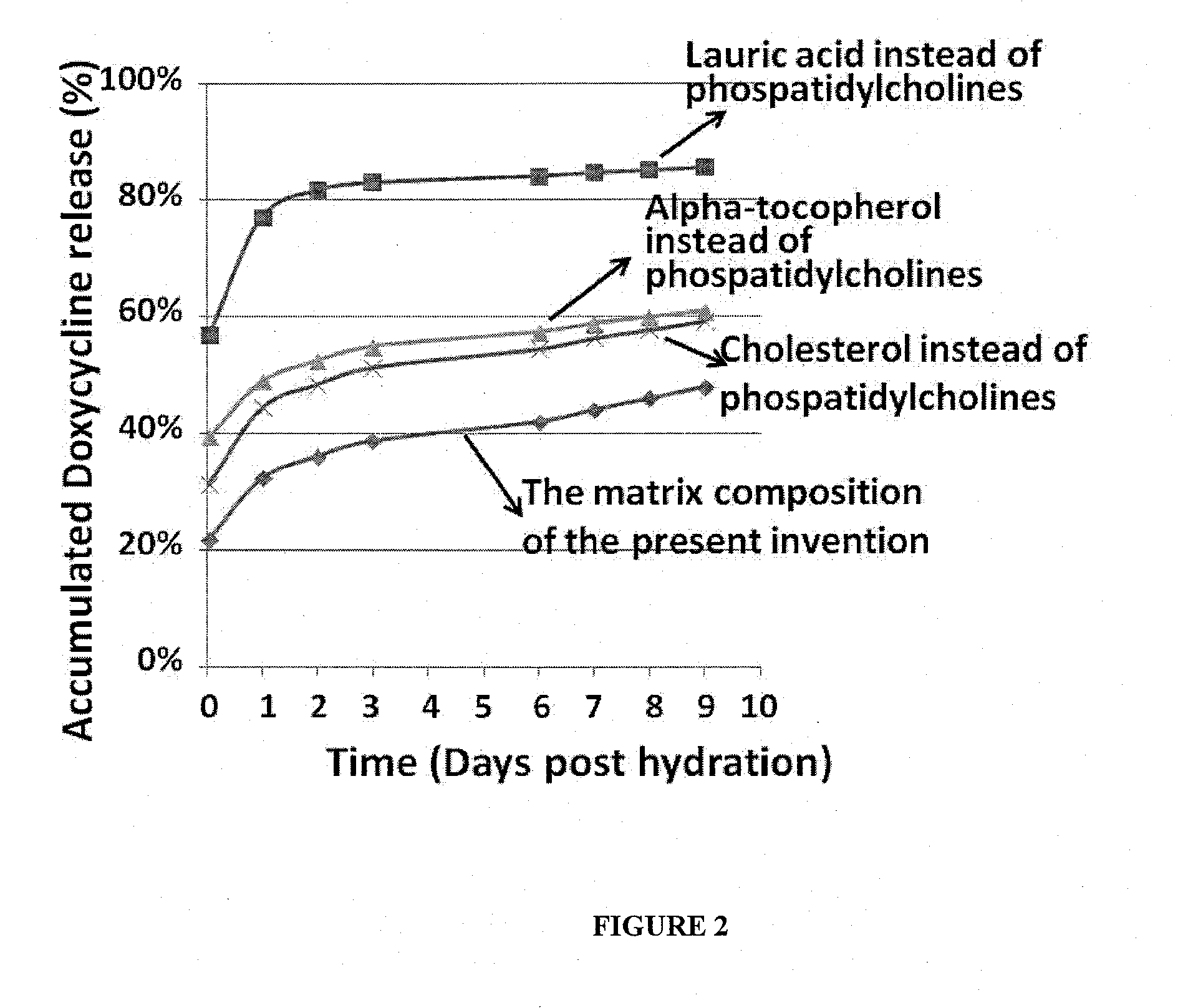Compositions and methods for the treatment of bone voids and open fractures
a technology for open fractures and voids, applied in the field of compositions, methods and medical devices for the treatment of bone voids or bone defects, can solve the problems of affecting the clinical effect of using this method, insufficient local concentration of drugs at the bone voids, and high severity of bone infections following such bone void defects, so as to prevent the potential rejection or early absorption of the potential drug, eradicate or prevent the possibility of bone infection, and enhance the formation of callus
- Summary
- Abstract
- Description
- Claims
- Application Information
AI Technical Summary
Benefits of technology
Problems solved by technology
Method used
Image
Examples
example 1
The Effect of Phosphatidylcholine Acyl Chain Length on the Release Rate of Doxycycline from Bone Particles Coated with the Matrix Composition According to Some Embodiments of the Invention
[0109]The preparation of the matrix composition with either DMPC, DPPC or DSPC, which only differ by 2 and 4 carbons in the acyl chains (14, 16 and 18 carbons, respectively) significantly affected the release rate of Doxycycline during the prolonged, zero-order release phase (Table 1). However, the length of the acyl chains did not significantly alter the release profile of the fast release phase. There was a clear linear increase (R2=0.976) in the release rate of the entrapped drug as a function of the reduced acyl chain length of the phospholipid used. There was more than 55% increase in duration of the release for DSPC (18:0) only vs. DMPC (14:0) only. In general, the preparation of the matrix composition with a mixture of these fully saturated phospholipids follows the same trend, but with some...
example 2
The Effect of Saturated Vs. Unsaturated Phosphatidylcholine on Matrix Properties
[0112]The matrix composition of the invention is saturated with lipids. The lipids are preferably saturated phosphatidylcholines and cholesterol. We have tested how the properties of the matrix composition (drug release properties, stability, ease of handling) are affected by changing the phosphatidylcholine from the saturated DPPC (16:0) to the non-saturated DOPC (18:1) without changing the amount and ratio of all other ingredients in the composition.
[0113]Results indicate that the overall release profile and release rate were not affected. However, TCP particles coated with a matrix composition comprising DOPC in contrast to DPPC were sticky, formed aggregates and were difficult to handle. In particular, homogenous mixture of coated and non coated particles was difficult to obtain.
[0114]Additionally, The TCP particles coated with a composition comprising DOPC were found to be unstable as indicated by t...
example 3
The Effect of Cholesterol on Doxycycline Release from the Matrix Composition of the Invention
[0116]The presence of cholesterol in the matrix composition significantly affected the release profile and release rate of Doxycycline during the prolonged, zero-order release phase. As can be seen in FIG. 1, upon reducing the amount of cholesterol in the formulation to 5% (w / w of the matrix composition) or lower the release of the antibiotic compound was not completed and was blocked after only 70% of the antibiotic compound was released. FIG. 1 also shows the importance of adding phosphatidylcholines having fatty acid moieties of 16 carbons to the matrix composition. When phosphatidylcholines were omitted from the composition, the antibiotic agent was release very rapidly, and full release was achieved within 10 days. Thus, the preparation of the matrix composition with at least DPPC, significantly affected the release rate of Doxycycline during the prolonged, zero-order release phase, ena...
PUM
| Property | Measurement | Unit |
|---|---|---|
| particles size | aaaaa | aaaaa |
| size | aaaaa | aaaaa |
| size | aaaaa | aaaaa |
Abstract
Description
Claims
Application Information
 Login to View More
Login to View More - R&D
- Intellectual Property
- Life Sciences
- Materials
- Tech Scout
- Unparalleled Data Quality
- Higher Quality Content
- 60% Fewer Hallucinations
Browse by: Latest US Patents, China's latest patents, Technical Efficacy Thesaurus, Application Domain, Technology Topic, Popular Technical Reports.
© 2025 PatSnap. All rights reserved.Legal|Privacy policy|Modern Slavery Act Transparency Statement|Sitemap|About US| Contact US: help@patsnap.com



